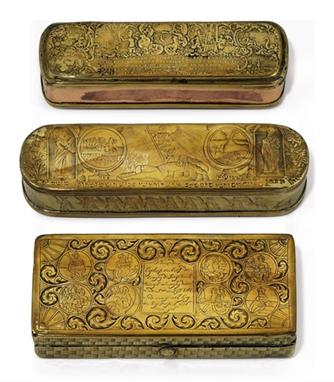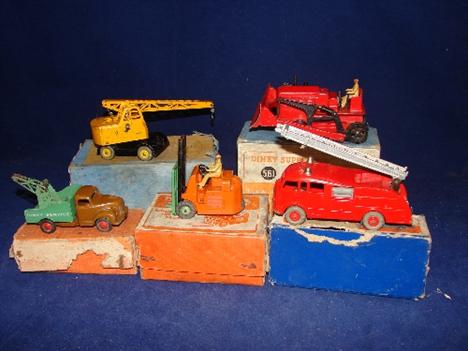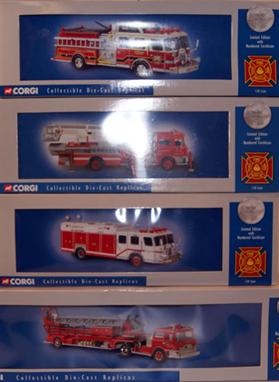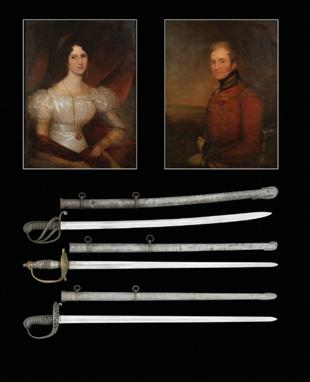We found 31159 price guide item(s) matching your search
There are 31159 lots that match your search criteria. Subscribe now to get instant access to the full price guide service.
Click here to subscribe- List
- Grid
-
31159 item(s)/page
A rare Bing OO gauge Miniature Table Railway A fine set comprising a clockwork 2-4-0 tender locomotive RN 4429 in LMS lined Crimson Lake livery, 2 x 4-wheel passenger coaches – 1st class and 3rd class brake, plus a signal box with chimney and exterior ladder, a country station in 3 sections incorporating separate end-ramps. The station has period advertisements, gabled roof and canopy to platform. There is also a tunnel, 2 signals and quantity of curved track. In addition there is a significant quantity of curved track plus a diamond crossing. Presented in a Bing Edwardian-style box, minor to some wear, contents VGC. Plate. 4
Johillco farm. Man pushing wheelbarrow, man with buckets and ladder (window cleaner). Mounted policeman, lady milking, milk maid, 2 seated women one with stool, 2 seated children on wooden log. Plus animals including 4 heavy horses, pony, foal and donkey. 3 bulls, 5 cows, one lying down and 3 calves. 9 sheep, 4 lambs, shepherd with lamb, sheep dog, 7 calves and a goat. VGC-Mint
A quantity of various makes including Franklin Mint: LaFrance fire appliance with ladder; Matchbox: 3 Yesteryear exploded views – Preston Tramcar, Yorkshire Steam Wagon, Leyland Titan TD 1, 2 mugs – Great Beers of the World, 4 Fire Engine Series, 1921 La France Fire Pump with wooden display plinth; Corgi: 2 x 1902 State Landau, Tramlines tram Bournemouth, Connoisseur Collection Jaguar XK120 Open Top on plinth. Together with a few other items. The more significant items boxed, minor/some wear, contents mostly VGC. (c35)
A small quantity of Matchbox Fire Engine Series including 1911 Mack Fire Engine, 1916 Ford T Fire Engine, 1923 Mack AC Water Tanker, 1930 Ahrens Fox Quad, 1932 Mercedes-Benz Ladder Truck 1948 Dodge Route Van Fire Support Truck, 1952 Land Rover Fire Tender and Trailer. All boxed, minor wear to some, vehicles VGC to mint. (c35)
14 Corgi fire vehicles including American La France Aerial Ladder Truck, La France Carnegie, The La France Fire Vehicles pair – Scottsdale and South River, Simon/Dennis Hydraulic Platform, AEC Pump Escape Nottingham, AEC Ladder Vehicle Cardiff, AEC Pump Escape Nottinghamshire, AEC Pumper Hertfordshire, Mini Van Fawley Refinery, Morris Minor Pick-Up Morris Motors FB. 3 x Fire Heroes series, Mack B Wrecker Chicago. All boxed, minor wear, contents VGC to mint.
13 Corgi vehicles including 2 x Limited Edition Collectables series: Renault Powder Tanker Damac, ERF Powder Tanker Rugby Cement, American La France Aerial Ladder Truck, Mack B Pumper Baltic CT, Scammell Highwayman Ballast and Low Loader Hallett Silbermann, Queen Mother’s Century Tram, HM the Queen’s 40th Anniversary set of 6 Thornycroft Vans. All boxed, minor wear, contents VGC to mint. .
10 Corgi haulage and other vehicles including Scammell Constructor and Low Loader with Load Sunter Bros, Diamond T Ballast with Girder Trailer and Locomotive Load Annis & Co, AEC Ergomatic with Box Trailer Bell’s, Renault Premium Curtainside Kent Connection, Foden S21 Platform Lorry with Diesel Tank Load Knowles Transport, La France Aerial Ladder Truck, Rolls Royce Corniche, London Taxi. All boxed, minor wear to some, contents VGC to as new.
Dinky: Bedford Ovaltine Van, Bedford Kodak Van, Blaw-Knox Bulldozer, Daimler Ambulance, two Bedford Refuse Trucks, Diesel Roller, Mersey Tunnel Police, green 25d Petrol Tank Wagon, 555 Fire Engine with unusual tan ladder, three 29c Double-Deck Buses, blue Royal Tiger Coach and Observation Coach, P-VG, three overpainted (15)
A LATE VICTORIAN DARK GREEN AND BLACK-JAPANNED AND LIVERY-PAINTED WAGONETTE BREAK BY PETERS AND SONS, LONDON, LATE 19TH CENTURY The open bobbin-railed rectangular back with facing benches with green cloth squab cushions and black back-rests, the driver's front box with conforming cushions including high seat and movable footrest, with hand-brake and livery-painted dashboard, the back with folding metal ladder, marked on each hub cap 'PETERS & SONS, LONDON', the sides with painted crests, with printed paper transit label 'The Rt. Hon. EARL SPENCER K.G. Althorp Park NORTHAMPTON L. & N.W. Ry', with pole and three team-bars, decoration in poor condition 86 in. (219 cm.) high; 70 in. (178 cm.) wide; 141 in. (358 cm.) long, without pole Rear wheels 53 in. (135 cm.) diameter Front wheels 37 in. (94.5 cm.) diameter View on Christie's.com
A EARLY VICTORIAN BLACK-JAPANNED AND LIVERY-PAINTED STANHOPE PHAETON BY PETERS AND SONS, LONDON, MID-19TH CENTURY With folding black leather calash top over two green cloth-covered cushions, a rubber trellis-lined footwell and a dashboard, with associated foot box and single rail support to the back bench seat, the back with crest with coronet and garter motto, fitted with a folding metal step-ladder, with one pole but no team bars, one spanner stamped 'SPENCER', marked on each wheel hub 'PETERS & SONS, LONDON', with a pair of black-japanned carriage-lamps by H. SMITH NORTHAMPTON, extensive losses and overall cracking to the decoration 100 in. (254 cm.) high; 63 in. (160 cm.) wide; 108 in. (275 cm.) long, without pole Rear wheels 46 in. (118 cm.) diameter Front wheels 38 in. (98 cm.) diameter View on Christie's.com
A GROUP OF THREE DUTCH BRASS TOBACCO BOXES 18TH CENTURY One with scenes from life of Moses including the Israelites receiving manna in the wilderness, angels ascending ladder to heaven, depictions of Moses and Aaron, men blowing horns and Hebrew inscriptions; another with vignettes and Dutch inscriptions and another with vignettes representing Europe and Asia, ships at sea and gentlemen drinking and smoking around a table First box 6¾ in. long (17 cm.) (3) View on Christie's.com
A pair of mahogany side chairs in George III style, by Howard & Sons Ltd, each with a pierced and leaf carved ladder back on blind fret stretchered supports, the front rails stamped `190, 4396, 1&2`, the underside of one chair with an ivorene plaque inscribed `HOWARD & SONS LTD 25, 26, 27 BERNERS ST., LONDON, W.`, late 19th century. (2) Lacking drop-in seats.
Five boxed Dinky diecast vehicles comprising farm tractor and hay rack no. 27AK, Pullmore car transporter no.982, heavy tractor in red no.563, fire engine with extending ladder no.555 and Dinky Supertoys elevator loader no.964 and Dinky Supertoys 20 tonne lorry-mounted crane `Coles` no.972 (illustrated)
A 1796 PATTERN HEAVY CAVALRY OFFICER`S FIELD SWORD BY DURS EGG with hatchet-pointed blade engraved `J. Runkel Solingen` on the back at the forte and with the Royal Cypher GR, the Royal Arms 1714-1801 and military trophies, retaining its leather washer; regulation `ladder` hilt with langets, with a rounded back-piece, prominent `nose` to the pommel, original leather-covered grip wound with silver wire, retaining an early leather liner and part of its leather knot, in its steel scabbard, with a single suspension ring (the other missing), and inscribed with the maker`s details at the locket (rubbed) 88cm; 34 1/2in blade The Egg family are well known as prominent gunmakers during this period. They were also major suppliers of muskets, swords and polearms to the board of Ordnance during the French Wars. See L. Southwick 2001, p. 102.
AN OFFICER`S JACKET, 6TH (OR INNISKILLING) DRAGOONS, CIRCA 1812-16 of scarlet wool with yellow wool facings, the front, skirts and cuffs trimmed with silver regimental-pattern lace 2 inches wide with a central black or very dark blue `ladder` train and fastening at the front with hooks and eyes; shoulder-cords of twisted silver square-cord secured at the neck with white metal hooks; lined in white linen, quilted in the collar, upper breast and shoulders with white wool which also reinforces the underarms; inner pocket to left breast; scarlet fly over the belly; some lining damage and moth; retaining metal hooks added in the 19th century for display This jacket conforms in general to that ordered for officers of heavy cavalry in 1812, but having the yellow facings and regimental-pattern lace of 6th Dragoons. AN OFFICER`S SHABRAQUE, 6TH (OR INNISKILLING) DRAGOONS, CIRCA 1804-16 of yellow wool, lined with buckram and grey wool and edged all round with silver regimental lace 2½ inches wide with a central black or very dark blue wool train; pierced in the central ridge in two places for harness; reinforced against the stirrup leathers with leather patches and with leather straps and buckles forward of the knee for pistol holsters; the regimental badge on both rear points embroidered in gold and silver wire and coloured silks; inked indistinctly inside `Cpt. Miller` (?); some staining and slight damage to the lining; retaining metal hooks added in the 19th century for display. Miller became a captain in 1804 and thus this shabraque is dated circa 1804-16, although it may relate to the earlier part of that period. AN OFFICER`S SABRETACHE AND SLINGS, 6TH (OR INNISKILLING) DRAGOONS, CIRCA 1812-15 the sabretache with a body and expanding pouch of black leather, the pouch lined with buckram and secured with a loop and button; the front of black or very dark blue wool (slight moth) with a border of regimental lace enclosing, in silver wire embroidery, the Royal Cypher GR beneath a monarchial crown in gold and silver wire embroidery and coloured fabric and above the regimental badge similarly embroidered, flanked by Union sprays embroidered in coloured silks and incorporating the regimental designation VI D in silver wire embroidery; three white metal suspension loops, the two slings of crimson Russia leather faced with regimental lace with white metal buckles, lace sliders and steel sprung catches, 34.5cm; 13⅝ in x 26.5cm; 10½ in This particular sabretache is noted and described in Carman, W.Y., `Sabretaches of Dragoons`, Journal of the Society for Army Historical Research, Vol. LXVII (1989), pp. 69-74, p. 73. AN OFFICER`S POUCH AND POUCH-BELT, 6TH (OR INNISKILLING) DRAGOONS, CIRCA 1812-15 the pouch body covered in brown leather and containing a wooden block pierced for six cartridges; the frontal flap of brown leather, covered in yellow wool edged with ⅝ inch regimental lace, without a central train, enclosing the regimental badge above and flanked by Union sprays, all embroidered in silver wire and coloured silks; one white metal loop for the belt; slight moth; the pouch belt in two parts (incomplete), one attached to the pouch by its loop and the other sewn to it for display; of brown leather faced with 2¼ inch regimental lace, without a central train, and edged with black or very dark blue wool; white metal buckle; generally good condition, frontal flap12cm; 4¾ in x 17cm; 6¾ in AN OFFICER`S WAIST-BELT, 6TH (OR INNISKILLING) DRAGOONS, CIRCA 1812-15 of crimson Russia leather faced with regimental lace, with a central train, 2¼ inches wide; three white metal loops for slings, the two outer 1⅜ inches wide and the inner 1 inch wide; plate of gilded brass or copper, 1⅝ in x 3⅛ in, with an applied regimental badge in white metal and a flat hook on the reverse to engage with a similarly shaped gilt metal loop; generally good condition, 5.7cm; 2¼ in wide AN OFFICER`S COCKED HAT, 6TH (OR INNISKILLING) DRAGOONS, CIRCA 1814-16 of black felted material to fold flat, edged with 1 inch black silk, tied across with a black silk regimental ribbon, 2 inches wide with two `ladder` trains, passing through a loop of silver gimp; a white metal star-loop set upon a black silk cockade of regimental ribbon and incorporating a white metal officer`s button; two crimson and gold bullion tassels linked by a plaited gold wire and crimson silk cord; lined in white silk with a white leather headband bearing the inked inscriptions: `Lt.Col. Miller Inniskilling Dns` and `Lt.Col. Miller`; retailer`s label of `Wagner Pall Mall`, height at back 19cm; 7½ in; at front 16.5cm; 6½ in Miller became a brevet lieutenant-colonel in 1814 and left the regiment in 1816; the hatters Wagner occupied premises at 89 Pall Mall at this period and are known to have supplied military headdress for both officers and other ranks. This cocked hat would probably have been worn, or carried, in levée dress. A 1796 PATTERN HEAVY CAVALRY OFFICER`S FIELD SWORD with hatchet-pointed blade engraved `J. Runkel Solingen` on the back at the forte and with the Royal Cypher GR, the Royal Arms 1714-1801 and military trophies, retaining its leather washer; regulation `ladder` hilt without langets, with a rounded back-piece, prominent `nose` to the pommel and a leather-covered grip (some worm) wound with silver wire; in its steel scabbard; with two loose rings; the blade edge with many nicks and the scabbard dented, 89cm; 35 in blade A 1796 PATTERN HEAVY CAVALRY OFFICER`S DRESS SWORD with double-edged blade of flattened elliptical section having a single central fuller; regulation gilt-brass hilt (no gilt remaining); the grip-covering absent; in its steel scabbard (some dents, rust staining and a hole at the chape) with a single loose split-ring, 78cm; 30¾ in blade
THE PROPERTY OF THE DESCENDANT FAMILY OF Captain Francis Stupart, 2nd (or Royal North British) Dragoons, circa 1808-21 A COMPANION PAIR OF PORTRAITS: CAPTAIN AND MRS FRANCIS STUPART, CIRCA 1821 oil on canvas, half length and contained in elaborate gilded-wood frames, that of Captain Francis Stupart showing him in regimental uniform, wearing the Waterloo Medal 1815 and with his field sword cradled beneath his left arm; overall condition fair, requiring some restoration 119.5cm; 47in x 99cm; 39in (framed) A 1796 PATTERN HEAVY CAVALRY OFFICER`S FIELD SWORD; A 1796 PATTERN HEAVY CAVALRY OFFICER`S DRESS SWORD AND AN 1821 PATTERN LIGHT CAVALRY OFFICER`S SWORD the first: with undecorated spear-pointed blade, regulation `ladder` hilt without langets and having a chamfered back-piece with `ears` and a leather-covered grip (some wear) wound with silver wire, in its steel scabbard (some rust-staining) with two loose rings; THE SECOND: with double-edged blade engraved in the central fuller `OSBORN & GUNBYS WARRANTED` and with the Royal Cypher GR and Royal Arms, regulation gilt-brass hilt with minute traces of gilding, the silver grip-wire partially unwound, in its steel scabbard (some dents and rust staining) with two loose rings; and THE THIRD: with undecorated blade of post-1846 `Wilkinson` type, regulation steel hilt (some slight traces of plating remaining) and fishskin-covered grip wound with copper wire, in its steel scabbard with two loose rings. the first: 86.4cm; 34 in blade the second: 77.5cm; 30½ in blade the third: 84.5cm; 33 1/4in blade Francis Stupart (1781-1860) was the son of John Stupart of Clackmannan. He was commissioned lieutenant in the Dundee, or 4th Forfarshire, Volunteer Infantry on 20th June 1803 and was commissioned cornet in 2nd (or Royal North British) Regiment of Dragoons on 5th May 1808, purchasing promotion to lieutenant in the regiment on 14th December 1809. Embarking for Flanders, with 390 fellow officers and men of his regiment, in April 1815, Stupart was second-in-command of the troop commanded by Captain Edward Cheney and their regiment was brigaded with 1st (or Royal) Dragoons and 6th (or Inniskilling) Dragoons to form the Union Brigade within the Cavalry Division of the army assembled under command of the Duke of Wellington to block Napoleon`s advance on Brussels. On 18th June 1815, Stupart and his regiment went into action at the Battle of Waterloo and he was among the 98 officers and men of 2nd Dragoons who sustained wounds in that battle. After Waterloo, Captain Edward Cheney was given the brevet of lieutenant-colonel and promoted within the regiment to the rank of major. Cheney`s promotion left a vacancy for command of his troop and Stupart was promoted into command, in the rank of captain, his commission being dated 20th July 1815. Stupart spent less than a year in command of a troop of 2nd Dragoons before going on Half Pay on 25th March 1816. He remained on Half Pay until 1844, in that year taking up a captaincy vacated through a promotion in 26th (or Cameronian) Regiment of Foot, then promptly selling the captaincy to a lieutenant in the regiment and retiring on the proceeds of the sale. Francis Stupart married, in Dublin on 8th April 1821, Anne, a daughter of John Jameson of Alloa. There were three children of the marriage: Margaret Haig, born 1823; John, born 1825 and Robert, born 1827. Stupart is buried in Warriston Cemetery, Edinburgh and his Waterloo Medal is in the possession of his regiment, now The Royal Scots Dragoon Guards (Carabiniers and Greys).
A .577 CALIBRE PERCUSSION ENFIELD THREE BAND MILITARY RIFLE, DATED 1867 with rifled sighted barrel retained by three bands and fitted with ladder back-sight, dated lock marked `Tower` and with a crown, walnut full stock, regulation brass mounts, and complete with its steel ramrod 97.5cm; 38 3/8in barrel
-
31159 item(s)/page











































